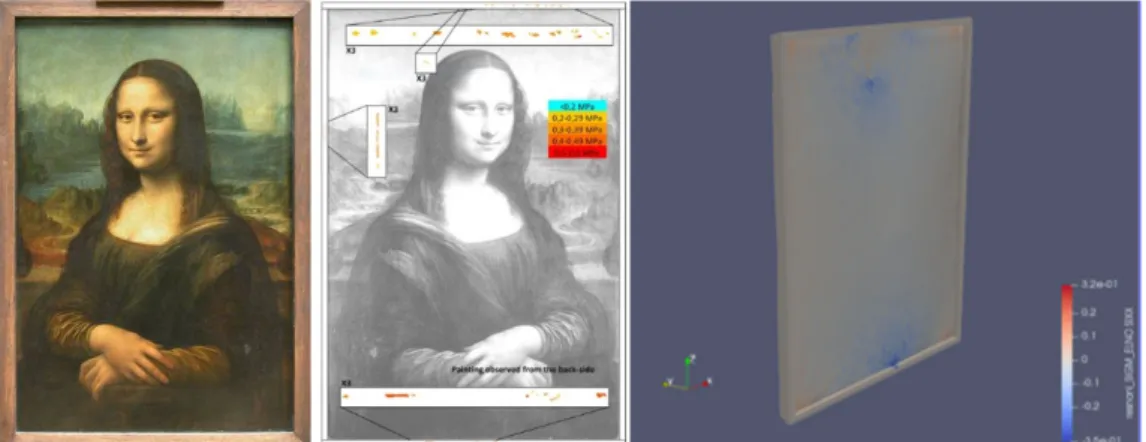102
ISBN: 978-91-88898-64-7
Studies for the Mona Lisa conservation: the implementation of its panel's Digital-Twin
RIPARBELLI Lorenzo1, BRÉMAND Fabrice2 DIONISI-VICI Paolo1, DUPRE Jean-Christophe2, GOLIGiacomo1, HESSER Frank2, JULLIEN Delphine3, MAZZANTI Paola1, TOGNI Marco1
RAVAUD Elisabeth4, UZIELLI Luca1, GRIL Joseph3,5
1
DAGRI (former-GESAAF), Univ. Florence, Florence, Italy,
lorenzo.riparbelli@unifi.it2 Institut PPRIME, Univ. Poitiers, CNRS, France 3 LMGC, Univ. Montpellier, CNRS, Montpellier, France
4 C2RMF, Centre de Recherche et de Restauration des Musées de France, Paris, France 5 Institut Pascal, Univ. Clermont Auvergne, CNRS, Sigma Clermont, Clermont-Fd, France
Since 2004, the wooden panel of the “Mona Lisa” painting by Leonardo da Vinci has been studied by an international research group of scientists [1,2] and several experimental campaigns have been carried out to understand its characteristics and provide information for the Artwork's conservation [3]. Among these, the implementation of its "digital twin" is here presented as a fundamental step for its conservation. Indeed, this digital twin is providing a deeper understanding of the mechanical characteristics of the panel, and after it has been accurately calibrated, it will provide the means for evaluating the stress states which the Artwork undergoes when the surrounding climatic conditions vary. Moreover, it will allow to evaluate in a non-invasive way the effects produced on the Artwork by any changes of its framing conditions, including the internal stresses or the external forces that it can bear without damage.
Figure 1: (left) the Mona Lisa panel inserted inside its frame; (centre) the contact areas between the panel and its frame, detected with pressure sensitive film; (right) the panel's numerical simulation to assess the stresses (σxx in MPa) induced in it by the contact
forces.
The implementation of the digital twin, through a Nelder-Mead optimization scheme, starts from the definition of the shape of the Artwork, through optical methods [4], and the identification of the boundary conditions, through an experimental campaign based on the use of a film sensitive to pressure [5]. During the whole year, while exhibited in the conditioned display case, the panel continuously tends to deform, due to the slight variations in the surrounding environment. Its mechanical behaviour is automatically monitored and recorded every 30 minutes by an ad hoc equipment placed close to its back face: four miniature load cells (located at the four corners) measure the forces pressing it against the frame, and three displacement transducers measure its deflection at mid height. Finally, a method is here described to compare two different framing conditions, through the numerical computation of point-by-point stress and deformation differences, in order to provide information for optimizing settings and constraints to Conservators.
References
[1] Riparbelli L., Dionisi-Vici P., Dupre J., Goli G., Jullien D., Bremand F., Mazzanti P., Hesser F., Marcon B., Togni M., Gauvin C., Arnould O., VALLE V., Dureisseix D., Cocchi L., Mandron P., Ravaud E., Uzielli L., Gril J. (2018) Mona Lisa’s digital twin: identifying the mechanical properties of the panel combining experimental data and advanced finite-element modelling, 7èmes journées du GDR Sciences du bois, Nov 2018, Cluny, France.
[2] Gril J., Cocchi L., Marcon B., Dionisi-Vici P., Goli G., Mazzanti P. Togni M., Uzielli L. (2015) The Mona Lisa Project: An update on the progress of measurement and monitoring activities, Euromech conference “Theoretical, Numerical, and Experimental Analyses in Wood Mechanics”, Dresden, DE, 27-29.05.15
[3] Mohen J.P., Menu M., Mottin B. (2006) Au Coeur de La Joconde, Gallimard, Paris
[4] Brémand F., Doumalin P., Dupré J.C., Germaneau A., Hesser F., Valle V. (2011) Mechanical structure analysis by Digital Image Correlation and Fringe Pattern Profilometry, Proceedings of Joint focused meeting, COST Actions IE0601 and FP0601 Non-destructive techniques to study Wooden Cultural Heritage Objects (WCHOs), 6-7 May 2011, Cité de la Musique, Paris, France
[5] Goli G., Dionisi-Vici P., Uzielli L. (2014) Locating contact areas and estimating contact forces between the “Mona Lisa” wooden panel and its frame, Journal of Cultural Heritage, 2013, vol. 15(4), 391-402.
